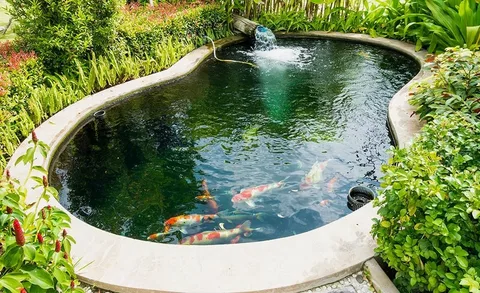Imagine a tranquil pond in your backyard—crystal-clear water, vibrant fish, and thriving aquatic plants. Sounds perfect, right? But keeping a pond in pristine condition isn’t a set-it-and-forget-it task. That’s where the Oase Screenmatic Pond Filter comes into play. It’s not just a filter; it’s a game-changer for pond enthusiasts who crave both beauty and low-maintenance functionality. In this in-depth guide, we’ll walk you through everything from its cutting-edge technology to installation tips and maintenance hacks.
Why Proper Pond Filtration is Crucial
Let’s be real—without a good filter, your pond is nothing more than a muddy, smelly pit. It’s like having a fish tank without a pump; chaos ensues. Filtration is the unsung hero of any aquatic setup, and it plays a crucial role in maintaining water quality. Poor water quality can lead to algae overgrowth, murky conditions, foul smells, and worst of all—sick or dying fish.
Filtration systems handle three key roles: mechanical, biological, and sometimes chemical filtration. They remove debris, break down harmful ammonia from fish waste, and stabilize the ecosystem so your pond doesn’t turn into a swampy nightmare. The Oase Screenmatic filter takes these basics and supercharges them with automation and intelligent design. That’s right—it filters smarter, not harder.
The Innovation Behind the Oase Screenmatic System
Oase didn’t just design a filter—they engineered a whole experience. The Screenmatic system revolutionizes the traditional filter setup by introducing automatic screen cleaning, a motorized belt system, and intelligent monitoring. Instead of constantly checking, scrubbing, and fretting over clogging issues, you get a filter that essentially maintains itself.
This system operates with a moving screen that captures large debris before it even enters the filter media. When the screen becomes clogged, sensors detect it and trigger a motor to roll the screen and push debris into a collection tray. No manual rinsing. No stress. That’s filtration in 2025—and it’s available today.
Understanding the Components of the Oase Screenmatic Filter
The Screenmatic Technology Explained
At the heart of the Oase Screenmatic filter is its self-cleaning screen belt. This isn’t just a fancy feature—it’s a pondkeeper’s dream. Large debris like leaves, uneaten fish food, and algae clumps are trapped early on, keeping the finer filter media from getting overloaded.
This filter doesn’t rely on your memory or attention span either. A built-in sensor constantly checks for resistance in the screen. When debris builds up, it triggers the screen to roll automatically. This prevents clogging and keeps the water flowing smoothly. The result? Less work for you and a much longer lifespan for your pump and biological media.
Mechanical vs. Biological Filtration Elements
The Oase Screenmatic doesn’t stop at mechanical filtration. After large particles are removed, the water passes through multiple layers of biological filter foams. These sponges house beneficial bacteria that break down harmful ammonia and nitrites into safer nitrates.
Some models also incorporate Hel-X biomedia, which offers an insanely high surface area for bacterial colonization. This boosts the biological efficiency of your pond and ensures a stable, healthy aquatic environment. Together, the mechanical and biological stages form a tag team that keeps your pond balanced and beautiful.
Smart Design and Automation Features
One of the standout features of this filter system is its digital control unit. You can monitor system performance, cleaning intervals, and even override the automatic cleaning cycle if needed. This is particularly helpful if you’re doing a big cleanup or making changes to your pond setup.
Many units also feature a UV clarifier built into the housing. This uses ultraviolet light to eliminate single-celled algae, the kind that turns your water green. So while the filter tackles physical debris and biological waste, the UV clarifier handles microscopic troublemakers. It’s a full-spectrum solution, all in one compact system.
Different Models of Oase Screenmatic Filters
Oase BioSmart vs. Oase BioTec Screenmatic
If you’re browsing the Oase catalog, you’ll come across both BioSmart and BioTec Screenmatic models. They sound similar, but the difference is in the details.
- Oase BioSmart is more of an entry-level option. It’s effective for smaller ponds and offers a combination of mechanical and biological filtration but lacks the high-tech automation features.
- Oase BioTec Screenmatic, on the other hand, includes the full auto-cleaning screen, a UV clarifier, and a higher capacity. It’s better suited for medium to large ponds with koi or high fish loads.
The choice depends on your pond size, budget, and how much automation you want. For most hobbyists who value efficiency and minimal maintenance, the BioTec Screenmatic is the clear winner.
Choosing the Right Size for Your Pond
Picking the right filter size is like choosing shoes—you don’t want them too tight or too loose. The same goes for your pond filter. Oase offers different capacities based on pond volume, fish load, and whether the pond is exposed to direct sunlight.
Here’s a quick rule of thumb:
| Pond Size (Gallons) | Suggested Filter Model |
| Up to 2,500 gallons | Screenmatic 40000 |
| 2,500–5,000 gallons | Screenmatic 60000 |
| 5,000–10,000 gallons | Screenmatic 90000 |
Overestimating a bit won’t hurt—it actually gives you more headroom during hot weather or heavy feedings. Just make sure your pump is compatible with the flow requirements.
Upgrades and Add-ons Available
Oase offers plenty of modular upgrades that can elevate your setup even further:
- UV-C clarifier extensions for increased algae control
- Aerators to enhance oxygen levels
- Remote monitoring tools via smart home integration
- Heating modules for year-round pond use
This modularity ensures your filtration system grows with your pond and needs. Think of it as buying a base iPhone and later upgrading with all the coolest accessories.
How to Install an Oase Screenmatic Filter
Tools and Materials Needed
Before you get your hands dirty, gather everything you need:
- Oase Screenmatic filter (model of your choice)
- Compatible pond pump
- Flexible tubing and hose clamps
- Power source with GFCI protection
- UV clarifier (if not pre-installed)
- Shovel (if burying the unit)
- Level and pliers
Trust me—having everything ready before you start will save you hours of frustration.
Step-by-Step Installation Process
- Position the Filter: Choose a flat, shaded area near the pond’s edge. Make sure it’s accessible for cleaning and maintenance.
- Connect the Pump: Link your pond pump’s output to the inlet of the Screenmatic filter using flexible hose.
- Secure with Clamps: Tighten hose clamps to prevent leaks.
- Setup the Outlet: Route the filter’s clean water outlet back to the pond or into a waterfall feature.
- Plug It In: Connect the power and turn on the system. Check for leaks or strange noises.
- Check Water Flow: Adjust the pump if needed to ensure optimal flow through the filter.
Boom! You’re up and running.
Common Mistakes to Avoid
- Placing the filter below pond level—it’s a gravity-fed system and works best when elevated.
- Undersizing the pump—this can choke the entire filtration process.
- Skipping UV clarifiers—bad move if you’re battling green water.
Maintenance and Cleaning Made Simple
Automatic Cleaning Mechanism
One of the greatest perks of the Oase Screenmatic system is its self-cleaning feature. The screen is monitored electronically and cleaned automatically when debris builds up. This ensures consistent water flow and minimizes downtime.
No more lifting out sponges covered in pond gunk every weekend. The debris is collected in an easy-to-remove tray. Just empty it when full. That’s it.
Conclusion
Keeping a pond clean, clear, and thriving shouldn’t feel like a full-time job. That’s exactly where the Oase Screenmatic Pond Filter shines—it offers a low-maintenance, high-efficiency solution that handles the heavy lifting for you. From its intelligent self-cleaning technology to its powerful mechanical and biological filtration, every component is designed to make pond care easy, effective, and even enjoyable.





